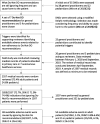Avoidable Adverse Events Related to Ignoring the Do-Not-Do Recommendations: A Retrospective Cohort Study Conducted in the Spanish Primary Care Setting
- PMID: 34009877
- PMCID: PMC8612910
- DOI: 10.1097/PTS.0000000000000830
Avoidable Adverse Events Related to Ignoring the Do-Not-Do Recommendations: A Retrospective Cohort Study Conducted in the Spanish Primary Care Setting
Erratum in
-
Avoidable Adverse Events Related to Ignoring the Do-Not-Do Recommendations: A Retrospective Cohort Study Conducted in the Spanish Primary Care Setting: Erratum.J Patient Saf. 2023 Apr 1;19(3):220. doi: 10.1097/PTS.0000000000001121. J Patient Saf. 2023. PMID: 36972318 Free PMC article. No abstract available.
Abstract
Objective: This study aimed to measure the frequency and severity of avoidable adverse events (AAEs) related to ignoring do-not-do recommendations (DNDs) in primary care.
Methods: A retrospective cohort study analyzing the frequency and severity of AAEs related to ignoring DNDs (7 from family medicine and 3 from pediatrics) was conducted in Spain. Data were randomly extracted from computerized electronic medical records by a total of 20 general practitioners and 5 pediatricians acting as reviewers; data between February 2018 and September 2019 were analyzed.
Results: A total of 2557 records of adult and pediatric patients were reviewed. There were 1859 (72.7%) of 2557 (95% confidence interval [CI], 71.0%-74.4%) DNDs actions in 1307 patients (1507 were performed by general practitioners and 352 by pediatricians). Do-not-do recommendations were ignored more often in female patients (P < 0.0001). Sixty-nine AAEs were linked to ignoring DNDs (69/1307 [5.3%]; 95% CI, 4.1%-6.5%). Of those, 54 (5.1%) of 1062 were in adult patients (95% CI, 3.8%-6.4%) and 15 (6.1%) of 245 in pediatric patients (95% CI, 3.1%-9.1%). In adult patients, the majority of AAEs (51/901 [5.7%]; 95% CI, 4.2%-7.2%) occurred in patients 65 years or older. Most AAEs were characterized by temporary minor harm both in adult patients (28/54 [51.9%]; 95% CI, 38.5%-65.2%) and pediatric patients (15/15 [100%]).
Conclusions: These findings provide a new perspective about the consequences of low-value practices for the patients and the health care systems. Ignoring DNDs could place patients at risk, and their safety might be unnecessarily compromised.
Trial registration number: NCT03482232.
Copyright © 2021 The Author(s). Published by Wolters Kluwer Health, Inc.
Conflict of interest statement
The authors diclose no conflict of interest.
Figures
References
-
- Otoom SA, Sequeira RP. Health care providers’ perceptions of the problems and causes of irrational use of drugs in two Middle East countries. Int J Clin Pract. 2006;60:565–570. - PubMed
-
- Find NL Terlizzi R Munksgaard SB, et al. . Medication overuse headache in Europe and Latin America: general demographic and clinical characteristics, referral pathways and national distribution of painkillers in a descriptive, multinational, multicenter study. J Headache Pain. 2015;17:20. - PMC - PubMed
-
- Verkerk EW Huisman-de Waal G Vermeulen H, et al. . Low-value care in nursing: a systematic assessment of clinical practice guidelines. Int J Nurs Stud. 2018;87:34–39. - PubMed
Publication types
MeSH terms
Associated data
LinkOut - more resources
Full Text Sources
Other Literature Sources
Medical


